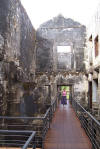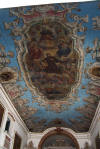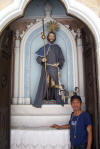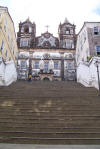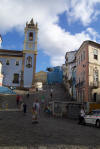Diary/Photo Journal
Week of March 12, 2006
For as long as I have known Gerson (it seems like ages!) he has talked about taking me to the State of Bahia and more specifically, around the city of Salvador. After reading several travel books and other similar literature, I knew I would see beautiful beaches, turquoise waters, diverse peoples, etc. and so I thought I knew what to expect. Was I wrong! The plane had not even landed yet and I was stunned by the magnificent beauty displayed in this part of Brasil.
Upon flying into Salvador, you feel as though it is mandatory that all things move a tad slower. The airplane seemingly slows down in mid-flight, your mind starts to organize its thoughts with great pauses, your eyes linger on the colorful objects around you and you just become hypnotized by the slow, steady pulsating mood of the place.
Even the flight into Salvador had my forehead connected to the inner window of the airplane as I watched atoll after island pass underneath and I found myself counting the sunfish that were doing what they are named for, sunning while lying on their sides. It looked like someone had scattered dozens of pieces of mirrors on the ocean's surface.
We hit the ground running, or should I say, driving, as we had rented a car and quickly made our way north toward Praia do Forte (Fort Beach). Not ones to pass up the opportunity to cool off at a small barraca (an intimate beachside bar/restaurant) we found one still serving carangueijo (they are at the very end of their season, hence the rather small versions). We spent a quiet afternoon sipping cold beer and breaking through crab shells.
But alas, the time came when we had to push further north and look for a pousada (rather cozy hotels) to rest for the evening. We found what we were looking for in Itacimirim (E-tah-cee-mir-em) and enjoyed the refreshing pool and deserted beaches. Also, we got to see first hand the work of a local organization called the Tamar Project that have been responsible for the protection and reintroduction of several species of sea turtles.
Once hunted for their gorgeous shells and their high-protein meat as well as their eggs being collected for easy food, the sea turtles that would migrate every year to these beaches were quickly being eradicated. A turtle-friendly couple saw the devastation of these reptiles that have remained relatively unchanged since dinosaurs stomped over the earth and they started a grass roots program to save the turtles.
The very same people that would hunt the turtles and collect their eggs are now paid to identify turtle nests, set up protection around the site and to report turtle happenings to the foundation. The conservation has been so successful, that over one million turtles have been released into the oceans and several of the species are off the endangered lists. One close look at these incredible reptiles makes you realize how much could have been lost had two people not taken the time nor made the effort to save these descendents of dinosaurs.
We spent part of our day walking the beaches and teasing the crabs that scuttle to and fro across the sand. The other part we wandered further up the coast to Praia do Forte wherein a wonderful little beatnik/tourist town lies and where the Tamar Project is located. We took the time to be in awe at the turtles as well as venture all around town.
From walking the beautiful beaches to watching the fishermen make nets to enjoying a pleasant meal surrounded by tropical plants unlike anything I have ever seen, we loved Praia do Forte.
As the name of the town suggests, there was a fort somewhere and we found it. Not so much of a fort as it was home to the first "governor" of the area, Garcia D'Avila. Inasmuch as it was his home, it was built like a fortress with its thick stone walls, many arches, numerous catwalks with sweeping views of the ocean and the nearby river. Built in 1552, this first great building in Brasil has lost its organic roof but still retains its incredible main structure.
After Praia do Forte, it was back to Salvador for a couple of days of sightseeing in the first capital city of Brasil (which had maintained that distinction since 1550 to the mid-1800's). A city built on slavery, it is considered the "African soul" of Brasil. While maintaining their cultural roots, the African slaves and their descendents have integrated their culinary, religious, musical, dance and martial arts into the Brazilian culture as a whole.
We found a hotel that was a bit beyond what we wanted to spend; however, for around $80 a night, we got breakfast, parking, use of the bar/restaurant dock on the bay (which included a water slide and diving platform), and what else...oh yeah, a 13th story view of the bay along with a Gondola that ferries you up and down the steep cliff to the water! Needless to say, Gerson was in the water before the waiter could bring me our beer (I say "our" beer because they serve the beers in liter bottles and we share to always ensure we drink it before it gets warm).
We tooled around in our rented car avoiding the crazy drivers that are loose everywhere in Brasil. We noticed a quaint little church built on a cliff and went in for a quick look. We were pleased to see a beautifully restored ceiling fresco. We moved on down hill and visited the Forte de Santo Antonio de Barra (yes, another fort) that is built around a magnificent lighthouse.
We gave over the car to the watchful young man that does nothing but assure you that if you pay him a couple of reais, he will not damage your car or let anyone else. This is a very common practice all over Brasil - paying someone to watch your car (usually where parking is free and on the street) and they provide a weak guarantee that you car will not be broken into or otherwise molested. You might roll your eyes, but in some parts of Brasil, it is a dollar well spent.
We walked along the bay, admiring some of the colonial architecture and watching the people. We landed upon one of our intended destinations, the Praca Municipal and the Elevador Lacerda. The Praca Municipal was the political seat for more than 200 years and the original Palacio Rio Branco was built in 1549 (it was partially reconstructed after a bombing and fire in 1919).
The Elevador Lacerda is the modern rendition of a manual elevator that the Jesuits installed around 1610. Using ropes and pulleys, the Jesuits used the "elevator" to transport goods and passengers from the port to the city. The various improvements to the elevator has led to its most recent version and the view from the elevator platform was incredible.
Traveling down the Elevador Lacerda, we landed at the Mercado Modelo, a restored Customs House built in 1861 (and partially restored in 1986 after yet another fire). The building has a rather notorious past as the arriving slaves were "stored" in the building's watery depths, awaiting their auction. Also, local superstition holds that the underwater basements are haunted and there have been many reported sightings of ghostly activity.
We stopped to have a cool drink and to watch the Capoeira (cap-oh-wayd-ah) "dancers" practicing/performing around the Mercado. As I mentioned before, Capoeira was developed from a ritualistic dance and martial arts followed by the African slaves. Again, being prohibited from practicing their arts, the slaves took their "dance" into hiding and the art evolved into a acrobatic dance that is Capoeira today. Disguised within the dance are many defensive moves that are performed to a rhythmic clapping of the hands and striking of the berimbau, a one-string musical instrument that looks like a bow with a bowl at the bottom.
Next was a jaunt uphill and long look at the historic and famous suburb of Pelourinho (Pel-or-een-yo). At the end of a colorful street, we found the Igreja da Ordem Terceira de Sao Francisco and the Igreja e Convento Sao Francisco. Both "churches" were finished in the early 1700's; however, each is unique in their splendor. And by splendor, I mean how much wealth was taken from the people and smelted in massive gold and silver monstrosities, carved in magnificent wood partitions and statues and painted in overwhelmingly complicated frescoes. Both churches are an example of the unbelievable indulgence of the religious leaders of that time.
We no sooner glanced in the direction of the Igreja da Ordem Terceira, when a smallish man with a toothless smile snagged my attention. Carmelito was a guide and within seconds he had us hooked. We usually avoid the guides as they are not that informative and rarely speak English; however, Carmelito not only knew his history, he spoke excellent English. Never judge a book by its cover!
A very interesting tidbit about this church is that in the late 18th century, the church fathers did not appreciate the Mason symbol, the eagle, that was built in the sandstone face and ordered the entire extraordinary facade covered with plaster. When wiring was to be installed in the building in the 1930's, workmen chiseled off some of the plaster and found the beautiful baroque sandstone carvings (the only one of its kind in Brasil) and a total restoration was completed.
It is said that the church was a secret meeting place for the Masons and their symbolism is everywhere. From pyramids to eagles to typical meeting rooms, the church was and is a bit of a contradiction to the religious norm. Hence, why the church fathers had one of their most impressive facades covered by boring plaster. Quite the Da Vinci Codeish conspiracy!
Fortunately, the church leaders did not think it necessary to cover the exquisite hand-painted porcelain tiles that were imported from Portugal. These tiles represent Lisboa, Portugal (Lisbon to you knaves) before a significant earthquake devastated the region. Pictured within the extensive tiled walls, are the fantastic buildings and other structures that at one time, shone on the shores of Portugal. Only one of the many arches shown survived and a few churches were able to be restored.
Wherein the exterior facade of the Igreja da Ordem Terceira da Sao Francisco was the remarkable feature of that church, the interior of its neighbor, the Igreja e Convento Sao Francisco was the exception of its construction. The indulgence of the church itself was so overwhelming that it took us long moments to grasp the beauty of what was created and put aside our repulsion from the thought of how much wealth was taken from the poor peasants to build this gold and silver monstrosity.
An interesting note about the Igreja e Convento Sao Francisco (besides its 165 pound or 80kg silver chandeliers) is that it was built by African slaves. The slaves were forcefully prohibited from practicing their own religion so they found a sly way to introduce their response into the building of the church.
When you look closely at the carved wood, gold-covered walls, you will see the results of the cover-up of cherubs with distorted faces, angels that were rather well endowed (not quite anatomically correct sex organs) and many other seraphs that appeared to be somewhat pregnant. Some of the chaste changes were not quite successful or unable to be completed without damaging the entire facade. We could easily see where the church leaders performed castration on the female angels and altered some of the male angels. What was considered an abomination by the church leaders, is now a fantastic note in the history of the church. Ironic...
We finished our lengthy walk through the two Igrejas and wandered up the street for lunch. We decided to keep Carmelito with us for the rest of the day, knowing we would provide him with a healthy payment for his services. We were entertained by a local menino (little boy) that juggled coconuts quite well and by the waiters that enjoyed being teased about their local soccer teams.
Walking through Pelourinho, we found color and life around every corner. Pelourinho was declared a World Heritage site in 1985 and since then, funds have been pouring in to restore the historic neighborhood. We can honestly say that the project is working. Without sacrificing too much of its older charm, the neighborhood was quaint and vibrant at the same time.
We spent a few hours traipsing up and down the hand-laid stone streets and before we knew it, we were back to where we started. We paid Carmelito probably the equivalent of a week's pay and dazedly strolled back to our car. Again, the Salvador slowness thickened around us and we were in no rush to go anywhere. A very pleasant day indeed.
Finishing a great week in the city of Salvador, we were even more excited to get ready to fly to Porto Seguro, the next leg in our tour of the State of Bahia.
Home Page Brasil-South America Diary Index Previous Diary page BR-SA Diary page 7


















